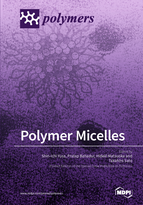Polymer Micelles
A special issue of Polymers (ISSN 2073-4360).
Deadline for manuscript submissions: closed (30 November 2017) | Viewed by 98668
Special Issue Editors
Interests: controlled/living radical polymerization; RAFT; TERP; water-soluble polymer; self-organization; polymer micelle; bioconjugate polymer
Special Issues, Collections and Topics in MDPI journals
Interests: surface; colloid; nano and polymer science; surfactant; block copolymer
Special Issues, Collections and Topics in MDPI journals
Interests: polymer surfactant; amphiphilic polymer; polymer micelle; polymer monolayer; polymer brush; polymer partile; ionic polymer
Special Issues, Collections and Topics in MDPI journals
Interests: polymer assemblies; concentrated polymer solutions; helical polymers
Special Issues, Collections and Topics in MDPI journals
Special Issue Information
Dear Colleagues,
Block and graft copolymers show microdomain formations in the solid state and self-assemble to core-shell nanoaggregates in selective solvents. Classically, amphiphilic polymers form polymer micelles and vesicular structures in aqueous solution, primarily due to the hydrophobic interaction in analogy to surfactants. Practically, polymer micelles have been applied as nanocarriers in drug delivery systems, solubilizers, associative thickeners, and so on. In recent years, various other interactions, such as electrostatic, hydrogen bonds, coordination bonds, and so on, have been found to play a role in polymer self-assembly. Additionally, unimolecular micelles may form by intramolecular association within a single polymer chain. Non-surface active polymers have also been found to form micelles. Furthermore, micelles from stimuli-responsive polymers and from mixtures of oppositely charged copolymers have been reported. Due to the advances in polymerization techniques leading to tailormade copolymers from a variety of monomers, characterization/solution behavior using a variety of modern instrumental techniques, theoretical approaches, and emerging areas of applications, polymer self-assembly has gained a great deal of interest in recent years and we need to constantly update the information and knowledge on polymer micelles. This Special Issue covers the synthesis, characterization, solution properties, association behavior, simulation, and application of polymer micelles, as well as polymer aggregates. The aim of this Special Issue is to expand our knowledge of polymer micelles by accumulating the latest basic and applicable information.
Dr. Shin-ichi Yusa
Prof. Takahiro Sato
Prof. Pratap Bahadur
Dr. Hideki Matsuoka
Guest Editors
Manuscript Submission Information
Manuscripts should be submitted online at www.mdpi.com by registering and logging in to this website. Once you are registered, click here to go to the submission form. Manuscripts can be submitted until the deadline. All submissions that pass pre-check are peer-reviewed. Accepted papers will be published continuously in the journal (as soon as accepted) and will be listed together on the special issue website. Research articles, review articles as well as short communications are invited. For planned papers, a title and short abstract (about 100 words) can be sent to the Editorial Office for announcement on this website.
Submitted manuscripts should not have been published previously, nor be under consideration for publication elsewhere (except conference proceedings papers). All manuscripts are thoroughly refereed through a single-blind peer-review process. A guide for authors and other relevant information for submission of manuscripts is available on the Instructions for Authors page. Polymers is an international peer-reviewed open access semimonthly journal published by MDPI.
Please visit the Instructions for Authors page before submitting a manuscript. The Article Processing Charge (APC) for publication in this open access journal is 2700 CHF (Swiss Francs). Submitted papers should be well formatted and use good English. Authors may use MDPI's English editing service prior to publication or during author revisions.
Keywords
- Polymer micelles
- Polymer self-assembly in aqueous solvents
- Polymer self-assembly in non-aqueous solvents
- Polymer vesicles
- Unimolecular micelles
- Self-assembly by non-surface active polymers
- Amphiphilic polymers
- Stimuli-responsive
- Drug delivery
- Self-organization









